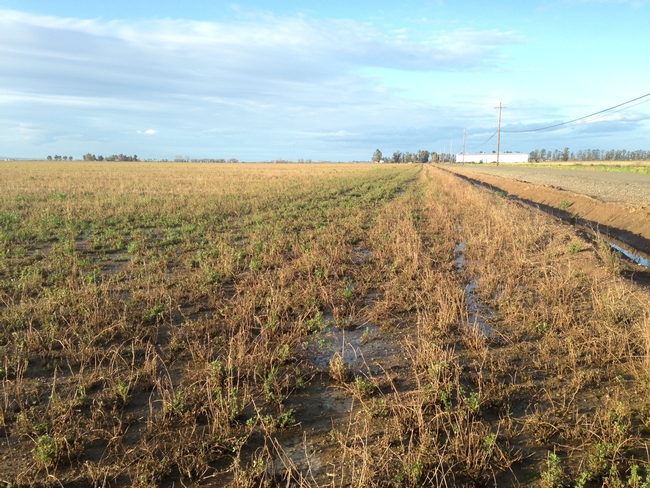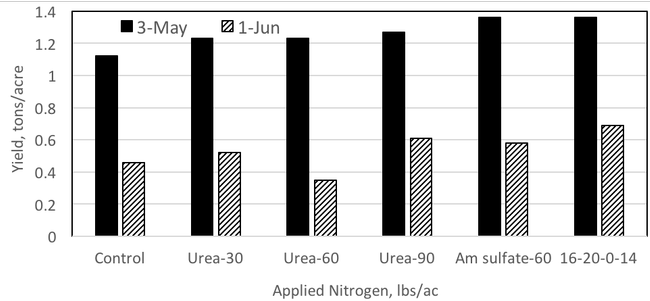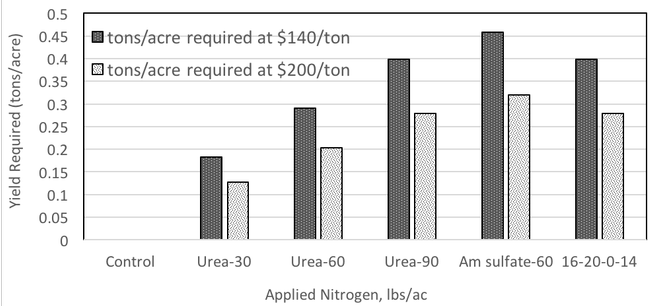Yellow plants equals nitrogen deficits—right? Maybe not!
When we have a very wet winter or spring, alfalfa fields may look yellow with diseased-looking leaves and delayed growth.
As farmers know, yellowing of leaves is a strong indication that nitrogen (N) may be limiting in the crop. Certainly that's true with corn, tomato, or wheat. It may also be the case in alfalfa too – but since alfalfa is a legume, it gets most of its N from biological nitrogen fixation (N2 fixation from bacteria which colonizes the roots, forming nodules), not from the soil. This ability enables alfalfa to grow well even on sandy N-depleted soils. N fertilizers are generally not recommended for alfalfa production.
Photo: Yolo County alfalfa field after heavy rains, Feb 10, 2017.
But what about our yellow stressed plants from flood damage? Is it worthwhile to consider whether to apply N fertilizers when alfalfa has been damaged by winter-spring flooding and in general, looks miserable? We have had questions from a number of growers about this.
Evaluating whether nitrogen will enhance water stressed alfalfa stands
A trial was conducted in Yolo County in 2006 to determine whether a 2-year old alfalfa stand would benefit from an application of nitrogen (N) to try to increase stand productivity after a particularly wet spring with 10-in of rainfall from March-April.
Urea at 30, 60, 90 lbs of N per acre, as well as ammonium sulfate (60 lbs of N), and 16-20-0-14 (30 lbs of N and 38 lbs of phosphorus) were applied to replicated plots before the first alfalfa harvest in the spring when there was standing water in the field. A separate trial was conducted in the same field with the same treatments and applied before the second harvest to see if this timing would increase yields.
Results
There was a modest trend for increases in yield due to N applications, but the differences were not statistically significant for either trial (Fig. 1 and 2). Overall, the high costs of fertilizers relative to the alfalfa yield gained did not justify the application in our study (based on $140/ton and $200/ton for the hay, Fig. 3). Lower value hay makes it even less attractive.
Although N may help an alfalfa crop to recover in some situations, our data suggest that applications of N fertilizers are of marginal benefit and likely not economically viable. In the case of this trial, the standing water severely affected stand health via saturated soil conditions and root disease intrusion. The addition of fertilizers did not help the stand recover as evidenced by the lack of significant yield response in either the first or second cutting for either trial. The plants needed to recover from the poor root environment.
When alfalfa is stressed from too much water, the plants are probably most limited by insufficient oxygen in the root environment and disease infestation, not N. This is not to say that N could have been a limiting factor – it is likely that many of the root hairs and nodules in these plants are compromised which limit nutrient uptake. It's just that additions of N fertilizers only had modest, non-significant effects on recovery.
As our previous blog discussions have shown (‘When is nitrogen fertilization of alfalfa beneficial?', //ucanr.edu/blogs/blogcore/postdetail.cfm?postnum=10478 ), N fertilizers in alfalfa are normally not economically advisable for alfalfa and could even promote weed problems.
When the rains stop and the soils begin to dry, the alfalfa will be able to start growing again and the rhizobium bacteria that fix the nitrogen will be able to re-infect the root and supply the needed N for rapid alfalfa growth.
Figure 1. Yield (tons/acre, 100% dry matter) as affected by supplemental spring nitrogen treatments on a flood-damaged stand of alfalfa. Fertilizers were applied April 13, 2006, with standing water on the soil surface. Alfalfa plots were harvested on May 3 and again on June 1. There were no significant differences in yields between treatments for either date. Low yields in the second harvest were likely due to stand decline and injury from standing water.
Figure 2. On May 15, 2006, after the first harvest of the season, another set of the same fertilizer treatments was applied in the same field. It was also harvested on June 1, 2006. Yields are in tons/acre for100% dry matter, with no significant differences between treatments.
Figure 3. Yield (tons/acre) required to justify a fertilizer application with hay prices of $140/ton and $200/ton. The cost of fertilizer materials were urea- $463/ton, ammonium sulfate- $375/ton, and 16-20-0-14- $484/ton, with an application cost of $10.50/acre by air.



